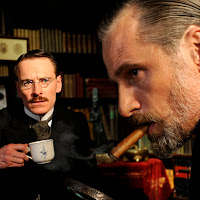 |
| Psychoanalyzing the Psychologists |
Scorsese has one. Kubrick has one. Cronenberg now has one. The Croneberg stare; in which a character looks into the camera, realizing what they lost is really what they wanted and all they have left to feel is remorse and self-hatred. This happens just seconds before the dramatic cut to black. This is repeated once again in “A Dangerous Method.”
Movies have a funny way of dealing with history. Some praise those movies that remain completely accurate to the facts, and others prefer those that deviate into historical fiction territory. “A Dangerous Method” is a restrained drama that wants to be an intense one and a piece that strives to be totally historically accurate yet deep down, it wants to be an insane piece of historical fiction.
“A Dangerous Method” begins at the turn of the 20th century as Carl Jung (Michael Fassbender), a budding star in the psychoanalysis movement, attempts to cure a seemingly incurable patient named Sabina Spielrein (Keira Knightley). Jung’s personality is one that is cold and impersonal, and he doesn’t even look at his patients when he speaks to them. The deeper Jung digs into Sabrina’s child issues, the closer the two become, and the more dangerous their relationship ultimately turns out to be. Let’s just say a touch of S&M is involved.
While Jung studies and beds Sabina (unbeknownst to his wife), he makes frequent trips to Vienna to visit his friend and mentor, the cigar-chomping Sigmund Freud (Viggo Mortensen). The two construct the foundations of early psychoanalysis but they have differing opinions on it. Freud is purely scientific and Jung is quite spiritual. They clash and talk but mostly, they just talk.

“A Dangerous Method” is not necessarily a bad movie. It is more like a good movie that missed the mark of greatness that it had the potential for. Oftentimes, this is even worse than a movie that is just bad. Cronenberg is an immensely talented director, especially when it comes to dealing with the darkest depths of human behavior. However, he never really makes movies on a larger scale, and a larger scale is exactly what “A Dangerous Method” could have used.
I walked into “A Dangerous Method” as a stranger to psychology. The many dialogues between Jung and Freud made me more interested in further exploring the subject on my own. However, it is the subject matter, and not the story created about it, that is so interesting here. It tries to tell too many different stories at once and therefore never effectively completes any of them. Cronenberg seems like he wants to focus more on Sabina, and while she has a twisted and interesting mind, there is much more fertile ground that needs to be explored in the rivalry between Freud and Jung. The movie sometimes feels like a vehicle for Knightley’s turn in a dramatic role. She is effective when she’s not hamming it up and being reminiscent of nothing more than a pirate princess.

But let’s back up to the rivalry between Freud and Jung, and the fact that it doesn’t even seem to exist. In the movie, it is less of a rivalry and more like an extended heated argument that leads to nothing once the steam cools. In one brief sentence, it is revealed that Sabina’s findings go against Freud’s findings on sex and the ego. It is addressed once, and then never brought up again. In another similar incident, Freud tells Jung he will reveal nothing of his thoughts to him as a way of remaining powerful over him. It is a strong moment that should have paved the way for an entirely different movie. Why wasn’t Jung more angry at Freud for this, when Jung knew that some of Freud’s findings were wrong?
“A Dangerous Method” should have taken a cue from a much better film about a rivalry during the birth of the new discoveries during the beginning of the 1900s: “There Will Be Blood.” The rivalry of that movie culminated into something much more horrific and tragic; a boom rather than a whimper. Maybe this story would have benefitted in the hands of a different director and a different writer.
“A Dangerous Method” is saved mostly by the outstanding performances of Fassbender and Mortensen. Fassbender rises to the occasion even with some of the flat dialogue he is given and Mortensen, meanwhile, depicts a tone and voice that are reminiscent of Alex DeLarge, who ironically could have used a serious couch session with Freud. The real star of the movie however, is cinematographer Peter Suschitzky. His stunning camerawork is romantic yet haunting; a mood that most perfectly captures the era. I could see myself watching this movie with the volume off and just being carried away by the imagery.
All of those great parts just feel like fragments. Occasional lines are thrown in here and there to show their importance but then are never brought back to their full extent. “A Dangerous Method” is like watching a very monotonous professor in a very crowded Psych 101 lecture. That is why that stare at the end feels blake rather than thoughtful at the end, as Cronenberg’s previous features (“A History of Violence”, “Eastern Promises”) left so much more to ponder. “A Dangerous Method” consists of many great parts searching for a much better movie to be a part of.

